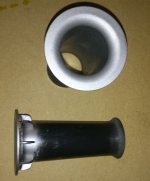since the Helmholtz resonator works with the mass of air in the duct the equivalent would be 41.67mm
It depends.
The Helmholtz resonator is controlled by (i) the mass of air enclosed in the port and (2) the area by which the port is coupled to the air in the box volume.
For practical purposes, just use one of those diameter numbers in your calculator, and make the port a bit longer than the calculator says. The measure the tuning frequency of the system and adjust the port length accordingly.
The Helmholtz resonator is controlled by (i) the mass of air enclosed in the port and (2) the area by which the port is coupled to the air in the box volume.
For practical purposes, just use one of those diameter numbers in your calculator, and make the port a bit longer than the calculator says. The measure the tuning frequency of the system and adjust the port length accordingly.
Science:
Tapered seems to be an odd design as their is equal flow in both directions. The taper would make a tiny difference in the through restriction on each end. In automotive racing, we use a 7 degree taper to make a tiny improvement in one direction flow while reducing cloud standoff. Tiny, but real.
Engineering:
Cut to measured is always the correct answer. Simulations are for prototyping and getting close.
Tapered seems to be an odd design as their is equal flow in both directions. The taper would make a tiny difference in the through restriction on each end. In automotive racing, we use a 7 degree taper to make a tiny improvement in one direction flow while reducing cloud standoff. Tiny, but real.
Engineering:
Cut to measured is always the correct answer. Simulations are for prototyping and getting close.
I am not sure why you consider the "flow" in the port. The Helmholtz resonator is concerned with the mass of air inside the port. It's not about the "flow".
- Home
- Loudspeakers
- Subwoofers
- A quick question about port volumes.
